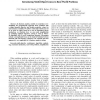Free Online Productivity Tools
i2Speak
i2Symbol
i2OCR
iTex2Img
iWeb2Print
iWeb2Shot
i2Type
iPdf2Split
iPdf2Merge
i2Bopomofo
i2Arabic
i2Style
i2Image
i2PDF
iLatex2Rtf
Sci2ools
132
Voted
ISDA
2010
IEEE
2010
IEEE
Avoiding simplification strategies by introducing multi-objectiveness in real world problems
Abstract--In business analysis, models are sometimes oversimplified. We pragmatically approach many problems with a single financial objective and include monetary values for non-monetary variables. We enforce constraints which may not be as strict in reality. Based on a case in distributed energy production, we illustrate how we can avoid simplification by modeling multiple objectives, solving it with an NSGAII algorithm with a novel comparison operator. Advantages include a strengthened focus on the trade-off relation between financial and non-monetary objectives. We conclude that this approach is very applicable in a business analysis setting. Keywords-multi-objective evolutionary algorithm, optimizing, constraint satisfaction, real world problems, simplification I. BACKGROUND AND OBJECTIVES When modeling problems in a real world setting, it is often necessary to find the optimum in a set of feasible solutions. In situations where this solution space is (very) large, many model buil...
ISDA 2010 | Operating System | Problems | Simplification | Solution |
| Added | 13 Feb 2011 |
| Updated | 13 Feb 2011 |
| Type | Journal |
| Year | 2010 |
| Where | ISDA |
| Authors | Charlotte J. C. Rietveld, Gijs P. Hendrix, Frank T. H. M. Berkers, Nadine N. Croes, Selmar K. Smit |
Comments (0)

